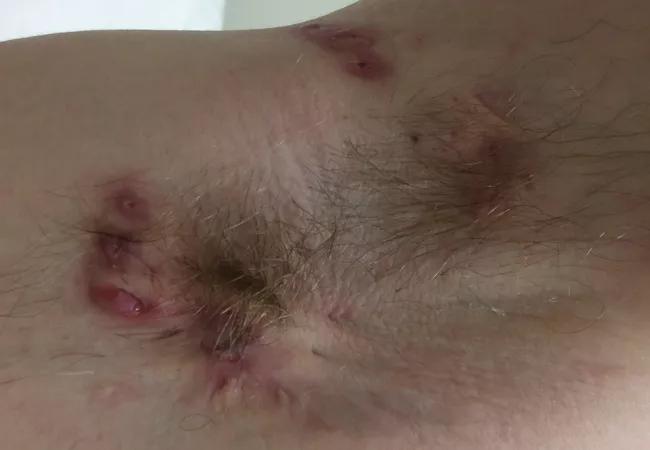Characteristics and outcomes

Advertisement
Cleveland Clinic is a non-profit academic medical center. Advertising on our site helps support our mission. We do not endorse non-Cleveland Clinic products or services. Policy
Patients with hidradenitis suppurativa (HS, acne inversa, and historically Verneuil’s disease) commonly present with abscesses, sinus tract formation, recurrent nodules and/or scarring primarily in the intertriginous areas. This inflammatory skin condition can cause profound morbidity, and HS has been reported to coexist with inflammatory eye disease (IED) in several cases. My colleagues in Cleveland Clinic’s Cole Eye Institute, Sunil Srivastava, MD, and Careen Lowder, MD, PhD, and I explored this association and patient outcomes in a recent report in the European Journal of Rheumatology.
The pathogenesis of HS is poorly understood but the role of immune dysregulation is believed similar to that of Crohn’s disease. Eye involvement is common in many inflammatory diseases, including Crohn’s. Given the case reports demonstrating association between HS and IED, and the hypothesis that HS shares systemic inflammation dysregulation similar to Crohn’s, we sought to explore the possibility that IED is a rare manifestation of HS.
We performed a retrospective chart review of Cleveland Clinic patients from January 2005 to January 2016 with HS and chronic IED. An independent ophthalmologist ensured the accuracy of IED diagnosis.
Of the 20 patients included in final analysis, 13 had uveitis, six had scleritis and one had peripheral ulcerative keratitis. Sixty-five percent of patients had autoimmune and/or inflammatory comorbidities. Forty percent had inflammatory bowel disease; other comorbidities included rheumatoid arthritis, systemic lupus erythematosus, ankylosing spondylitis and multiple sclerosis. Treatments and remission rates were as follows:
Advertisement
Ultimately, our study is limited by its small size and retrospective nature, but it sheds further light on the multiple case reports linking HS and IED. The one-third of patients with IED but without any autoimmune or inflammatory comorbidity appears to support our hypothesis of a common pathogenic link between the two. We also don’t have enough data to recommend a course of treatment for patients, though most of our patients (70 percent) did not respond to first-line therapy (topical steroids) and required escalation to systemic immunosuppressive agents.
This association deserves further attention from larger studies, but for now, clinicians should remain aware of a possible association between HS and IED, perhaps arising from similar immune dysregulation phenomenon linking Crohn’s and HS.
Advertisement
Advertisement

Registry data highlight visual gains in patients with legal blindness

Prescribing eye drops is complicated by unknown risk of fetotoxicity and lack of clinical evidence

A look at emerging technology shaping retina surgery

A primer on MIGS methods and devices

7 keys to success for comprehensive ophthalmologists

Study is first to show reduction in autoimmune disease with the common diabetes and obesity drugs

Treatment options range from tetracycline injections to fat repositioning and cheek lift

The advanced stage of diabetic retinopathy is among the most challenging for retinal surgeons